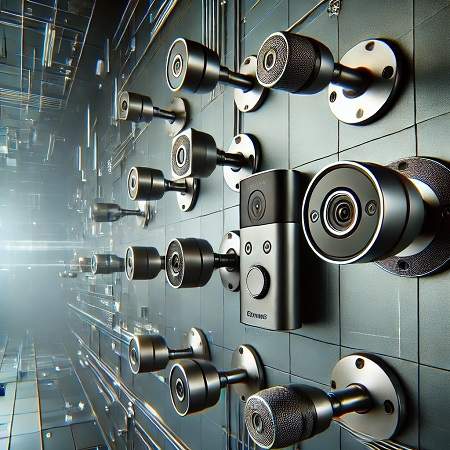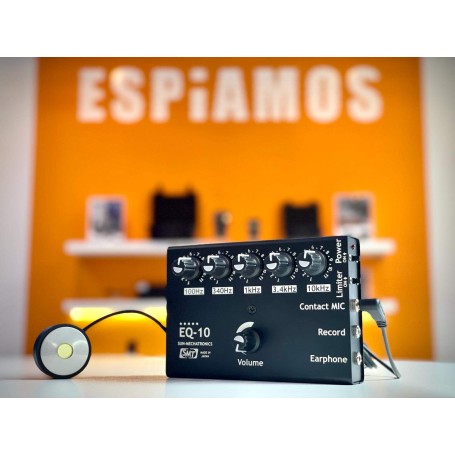Wall microphones are essential tools in the world of modern surveillance, allowing espionage and security professionals to capture conversations through solid surfaces. These devices have evolved significantly over the years, from the first rudimentary models to the advanced technology we know today. In this article, we will explore how they have changed over time, their current features, and the most common applications in the security field.

Table of Contents
- History of Wall Microphones
- Technological Evolution of Wall Microphones
- How Wall Microphones Work
- Advantages of Wall Microphones
- Conclusions
History of Wall Microphones
The history of spy microphones for walls is closely linked to the development of covert listening technology. These devices were born in response to the need to pick up conversations without being detected, something that was initially achieved in a rudimentary way. In the early days of surveillance, the methods were quite simple and ineffective. Often, acoustic tubes were used that transmitted sound through walls, similar to the stethoscopes used in medicine.
Over time, as electronic technology advanced, spy microphones began to incorporate more sophisticated components. The first electronic listening devices , developed in the mid-20th century, were bulky and not very portable. These systems required direct contact with the surface to be spied on and did not have the ability to filter out background noise or interference, which made audio clarity difficult.
It was in the 1960s and 1970s that the first more compact and easy-to-use contact microphones began to emerge. The development of more sensitive microphones and sound amplifiers allowed security and intelligence agencies, as well as private investigators, to improve the effectiveness of their undercover operations. From that point on, technology continued to advance, refining both the quality of the devices and their accessibility for professionals in the sector.
Technological Evolution of Wall Microphones
The technological evolution of wall microphones has been impressive. Today's models are the result of decades of innovation in the field of surveillance and espionage. Today, microphones for listening through walls incorporate technologies that optimize sound pickup and offer unprecedented audio clarity, even through thick surfaces such as concrete or metal.
One of the most important innovations was the incorporation of specialized probes, such as needle or flat probes, which improve sound pickup depending on the type of surface. These probes allow vibrations to be captured more precisely, transmitting the sound to an amplifier that eliminates unwanted noise. In addition, advances in frequency equalizers have allowed users to manually adjust soundtracks to improve audio quality and highlight human voices over background noise.
Another significant technological advancement is the ability of these microphones to record audio autonomously or transmit it in real time to external devices. This has allowed for greater flexibility in surveillance operations, as the user can gather the information and store it without the need to be physically close to the location. With the miniaturization of electronic components, it is now possible to find extremely small and discreet wall-mounted spy microphones, which can be easily hidden anywhere.
Noise Filters and Equalizers
One of the most notable innovations in modern wall microphones is the use of noise filters and advanced equalizers. These systems allow the user to adjust frequencies to eliminate disruptive noises, such as traffic or machinery noise, and focus on specific sounds such as conversations. Noise filters are especially useful in urban or industrial environments where interference is common. Equalizers, on the other hand, offer more precise control over the frequencies that are picked up, improving the quality of surveillance.
Real-Time Recording and Streaming
Another key improvement is the ability to record and transmit the captured audio in real time. This functionality is indispensable in operations where it is crucial to have the information at the moment, without having to wait to access the device to listen to the recording. Some wall microphones are equipped with transmitters that send the audio signal to a remote receiver, which increases security and discretion in surveillance missions.

How Wall Microphones Work
The basic principle behind the operation of a spy wall microphone is the capture of the vibrations generated by sound waves when they pass through solid surfaces. Unlike conventional microphones, which capture sound through the air, contact microphones are designed to pick up vibrations directly from the surface, allowing them to "listen" through walls, ceilings or doors.
These devices have a probe that is placed on the surface to be monitored. The probe can be a needle, for thinner surfaces, or flat, for thick walls. Once in contact, the sound vibrations that occur in the room or area being monitored are picked up by the probe and transmitted to an amplifier. This amplifier amplifies the signal so that it can be heard through headphones or recorded on an external device.
One of the key features of wall-mounted microphones is their ability to filter out unwanted interference. Through equalization systems, the user can adjust the frequencies picked up, eliminating background noise and amplifying voices or other relevant sounds. This is especially useful in noisy environments, where ambient noise could interfere with listening.
Vibration Probes and Sensors
Wall microphones use specialized probes to pick up vibrations. These probes are equipped with vibration sensors that detect even the smallest movements on the surface. As sound waves travel through the wall or ceiling, the vibrations are picked up by the probe and converted into electrical signals. These signals are then amplified to convert them into auditable sound.
Depending on the thickness and material of the surface, the type of probe used may vary. Needle probes are more suitable for thin walls or doors, while flat probes are more effective on thick surfaces such as concrete. In both cases, the technology behind the vibration sensors ensures accurate sound pickup.
Advantages of Wall Microphones
Wall microphones offer numerous advantages for those who need to carry out covert surveillance tasks efficiently and discreetly. These devices, designed to pick up sounds through solid surfaces, provide a number of benefits that make them indispensable in the field of security. Below, we analyze some of the main advantages they offer.
Discreet Listening
One of the main advantages of wall microphones is the ability to conduct eavesdropping in a completely discreet manner. These devices are virtually invisible when placed correctly, making them an ideal tool for covert operations. By capturing vibrations directly from the surface, they do not require being located within the same room as the conversation, which avoids raising suspicions.
In addition, many current models are extremely compact and easy to conceal, which means they can be installed anywhere without attracting attention. This feature is crucial in professional surveillance scenarios, where discretion is key to not compromise the operation.
Clear Pickup Through Thick Surfaces
Modern wall microphones are designed to effectively pick up sounds through solid, thick surfaces such as concrete, wood or metal walls. Thanks to technological innovations in contact probes and sound amplifiers, these devices can deliver excellent audio quality even in the most challenging conditions.
The ability to adjust the frequencies picked up using equalizers or noise filters allows the user to amplify voices and remove unwanted noise, significantly improving audio quality. This is especially useful in urban or industrial environments, where background sounds can interfere with listening clarity.
Versatility in Different Scenarios
Another great advantage of spy microphones for walls is their versatility. They can be used in a wide variety of situations and environments, making them a valuable tool for both security professionals and private investigators. These devices are useful in office buildings, residences, government facilities, or industrial areas where undetected eavesdropping is necessary.
Additionally, wall-mounted microphones are portable and easy to transport, allowing them to be taken from one operation to another without any hassle. This flexibility gives them an advantage over other listening methods that may be more limited in mobility or require more complex installation.
Autonomy for Extended Operations
Battery life is a key factor in any surveillance equipment, and wall-mounted microphones are no exception. More advanced models can operate for long hours without the need for recharging or battery changes, making them an excellent choice for extended operations. This is especially important in situations where access to the device is limited or it is not safe to return to change batteries during operation.
Additionally, some wall microphones can record audio for hours and store it on internal memory devices or transmit it in real time to a remote receiver. This adds an additional layer of security for professionals who must collect evidence without being physically present at the wiretapping location.
Conclusions
In short, wall microphones have revolutionised the way covert surveillance is carried out. Thanks to their advanced features, such as contact probes, noise filters and the ability to record or stream in real time, these devices offer an effective and discreet solution for security professionals. Their evolution over the years has allowed them to be essential tools in the arsenal of any private investigator, law enforcement agency or spy agent today.
The ability to pick up sounds through solid surfaces with excellent audio quality, ease of use and portability are just some of the advantages offered by these microphones. In addition, their ability to adapt to different environments and situations makes them the ideal choice for those who need to carry out prolonged listening without being detected.
If you are considering integrating wall-mounted microphones into your surveillance operations, it is crucial to evaluate the features that best suit your needs. From frequency adjustment capabilities to battery life to device ruggedness, all of these factors must be taken into account when choosing the best microphone for your mission.
Frequently Asked Questions (FAQ)
1. What type of surfaces can wall microphones pass through?
Contact microphones are designed to pick up sounds through a variety of solid surfaces, such as concrete walls, wood, metal, and doors. Depending on the thickness and material of the surface, some microphones may provide better results than others, so it is important to select the right device for your environment.
2. Do you need to be in the same room to use a wall microphone?
No, the advantage of wall microphones is that they can pick up sound vibrations through surfaces, so you don't need to be in the same room to hear what's going on. This provides a huge advantage in terms of discretion and security.
3. Are the wall microphones visible once installed?
No, most wall microphones are designed to be extremely discreet and easy to conceal. They can be installed without arousing suspicion, making them an ideal choice for covert operations.
4. Can I record audio captured with a wall microphone?
Yes, many wall microphones allow direct recording of the captured audio. This is done via an external storage device or through a recording system built into the microphone itself. Some models can also transmit the audio in real time to a remote receiver.
5. How do noise filters work on wall microphones?
Noise filters allow you to eliminate unwanted background noise or interference, such as traffic or machinery. This is achieved by adjusting the sound frequencies picked up by the microphone, allowing the user to amplify human voices or specific sounds and eliminate disruptive noises.






 WhatsApp
WhatsApp Telegram
Telegram


